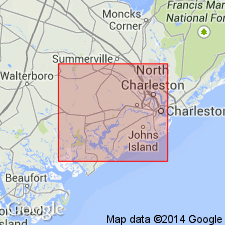
- Usage in publication:
-
- Harleyville Member*
- Modifications:
-
- Named
- Dominant lithology:
-
- Limestone
- AAPG geologic province:
-
- Atlantic Coast basin
Summary:
Named the Harleyville Member of the Cooper Formation for Harleyville, Dorchester Co., SC. Consists of olive-gray and greenish-gray, compact, fine-grained, fossiliferous, phosphatic calcarenite. Thickness ranges from 3 to 30 m. Unit unconformably overlies the Cross Member of the Santee Limestone and unconformably underlies the Parkers Ferry Member or Ashley Member of the Cooper Formation. The Harleyville is of late(?) Eocene and early(?) Oligocene age.
Source: GNU records (USGS DDS-6; Reston GNULEX).

- Usage in publication:
-
- Harleyville Member*
- Modifications:
-
- Revised
- Age modified
- AAPG geologic province:
-
- Atlantic Coast basin
Summary:
In this discussion of the Clubhouse Crossroads Corehole #1, Cooper Formation and its Harleyville, Parkers Ferry, and Ashley Members are used to conform with previous usage. Age of the Harleyville is late Eocene.
Source: GNU records (USGS DDS-6; Reston GNULEX).
- Usage in publication:
-
- Harleyville Formation
- Modifications:
-
- Revised
- Dominant lithology:
-
- Calcarenite
- Calcisiltite
- AAPG geologic province:
-
- Atlantic Coast basin
Weems, R.E., Albright, L.B., III, Bybell, L.M., Cicimurri, D.J., Edwards, L.E., Harris, W.B., Lewis, W.C., Osborne, J.E., Sanders, A.E., and Self-Trail, J.M., 2016, Stratigraphic revision of the Cooper Group and the Chandler Bridge and Edisto Formations in the Coastal Plain of South Carolina: South Carolina Geology, v. 49, p. 1-24.
Summary:
Pg. 3 (fig. 2), 4, 5-6, 7 (fig. 4), 21 (tbl. 6, fig. 13). Harleyville Formation of Cooper Group. Occurs below Ashley Formation and above Parkers Ferry Formation (both of Cooper Group); formations separated by unconformities. Harleyville considered younger than Parkers Ferry, not older, as previously thought. At type section of the Harleyville, the Parkers Ferry is absent and the Harleyville unconformably overlies /Pregnall Member of Tupelo Bay Formation (beds previously assigned to Cross Member of Santee Limestone).
In subsurface (USGS OS-1 core, Ravenel area, Osborn 7.5-min quadrangle, Charleston County, southern South Carolina), Harleyville Formation assigned to beds previously informally called Drayton limestone by Weems and others, 1987 (USGS Open-file Rpt. 87-661, p. 84) and Drayton limestone beds by Weems and Lemon, 1996 (USGS Misc. Inv. Ser. Map I-2491, sheet 2). Subdivided into newly named members (descending): /Drayton, occurs locally in subsurface only; and Osborn. Underlies Ashley Formation and overlies Parkers Ferry Formation. Beds below the Parkers Ferry, that were previously assigned to the Harleyville, are reallocated to /Pregnall Member of Tupelo Bay Formation.
At type section of Parkers Ferry Formation (Clubhouse Crossroads no. 1 corehole, Clubhouse Crossroads 7.5-min quadrangle, Dorchester County, southern South Carolina), the Harleyville is absent and the Parkers Ferry unconformably underlies Ashley Formation. Beds below the Parkers Ferry, that were previosuly assigned to the Harleyville [see Geosummary log in Gohn and others, 2000, USGS Open-file Rpt. OF00-49, Chap. C], are reallocated to /Pregnall Member of Tupelo Bay Formation.
Age is considered late Eocene (late Priabonian) based on fossils; calcareous nannofossil zone 21 [and uppermost part of NP19/20?], planktic foraminifer zones P 16/17. [In fig 2, Harleyville shown within lower half of calcareous nannofossil zone NP21 (reference not given). In fig. 13, base of Harleyville is extended downward into uppermost NP19/20 (cites Vandenberghe and others, 2012, Paleogene Period, IN Gradstein and others, The geologic time scale 2012).]
Source: Publication.
For more information, please contact Nancy Stamm, Geologic Names Committee Secretary.
Asterisk (*) indicates published by U.S. Geological Survey authors.
"No current usage" (†) implies that a name has been abandoned or has fallen into disuse. Former usage and, if known, replacement name given in parentheses ( ).
Slash (/) indicates name conflicts with nomenclatural guidelines (CSN, 1933; ACSN, 1961, 1970; NACSN, 1983, 2005, 2021). May be explained within brackets ([ ]).

